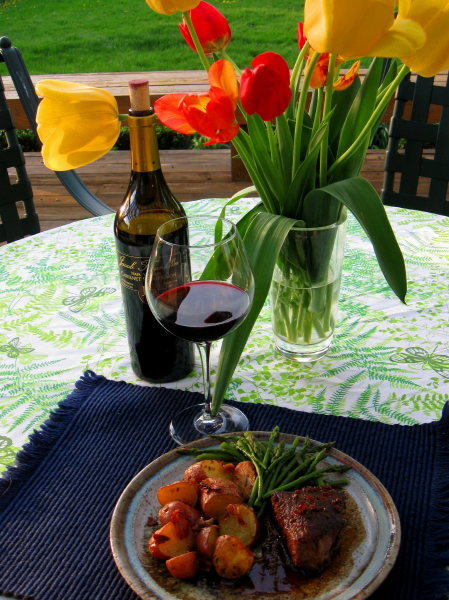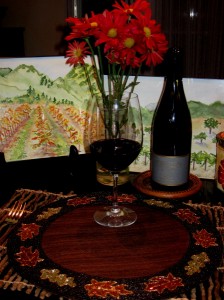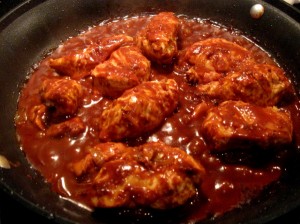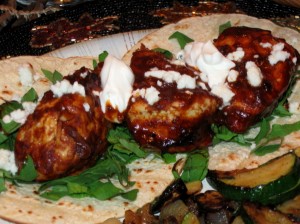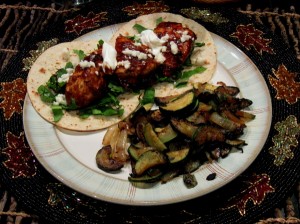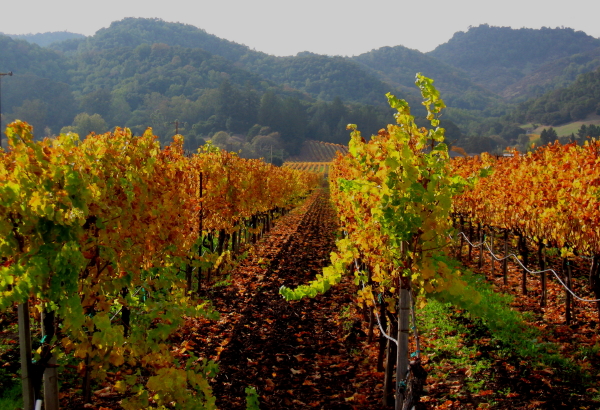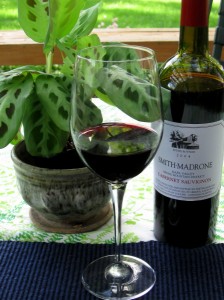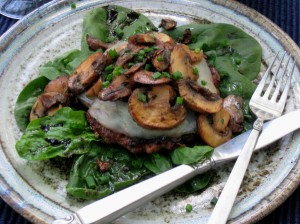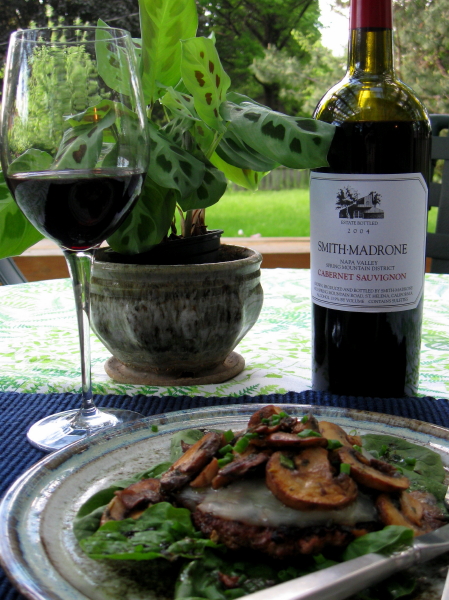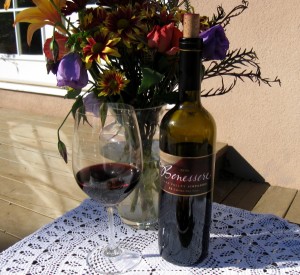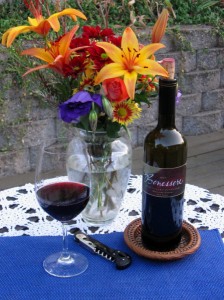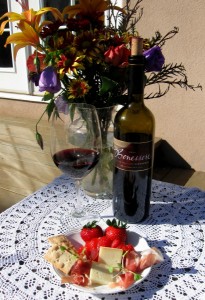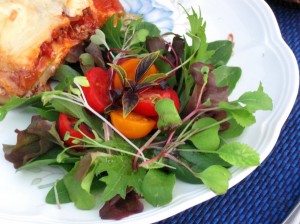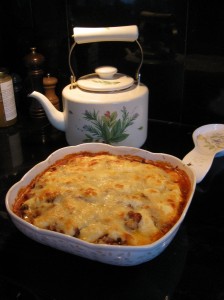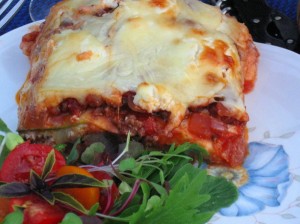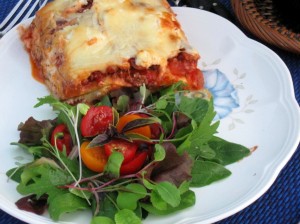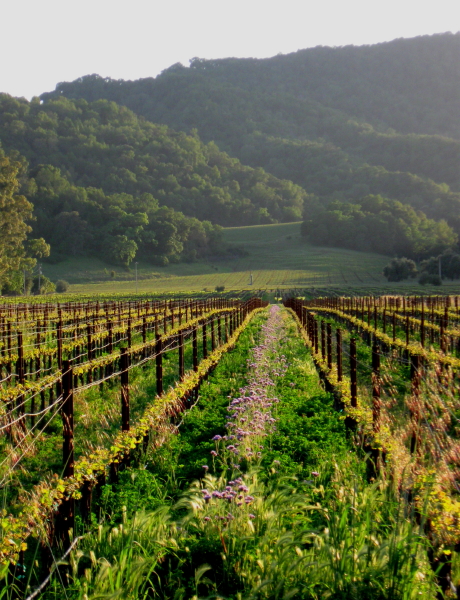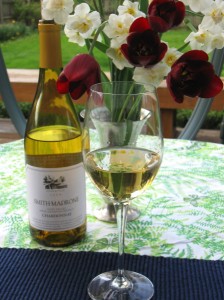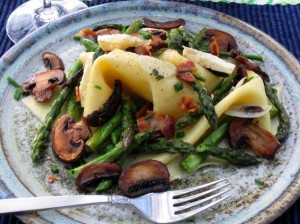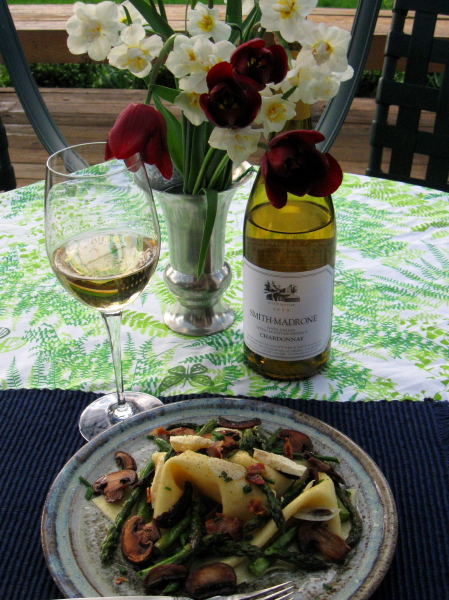
Cabernet Sauvignon is a varietal in Napa Valley that is simply king of the valley. Certainly there are countless other varietals that do well here, but it is the combination of soil and climate that allows this grape to flaunt its thick skin and show what it is made of.
The grape is perhaps the best known red wine grape and I have watched around the country and with visitors from abroad that when I am nudged to pick a wine the request is for a Cabernet Sauvignon. Regardless of the individual requesting the grape, there is always a slight air about the way “Cabernet Sauvignon” is said. It is said with a certain air of respect, at times snobbery and passionate humility.
What is it about this varietal that draws so many palates to the glass? For one, it historically in the United States has been the red wine choice in restaurants when wine lists may not be extensive. This is often due to the wine more often than not being able to deliver a solid structure, easily recognizable fruit, tangible tannins and a detectable lingering finish that leaves the palate either contemplating or simply wanting another glass. It is the dinner guest at the table that will help command the meal, often no matter the ultimately ordered main course.
Generally speaking, the Cabernet Sauvignon grape has a thick skin, is one of the last grapes to bud on the vine (making it less susceptible to mold or rot if you have a chilly spring) and is ready to harvest late (allowing it to reap the last of summer and at times early autumn lingering heat). It loves the warmth of the sun and similarly loves to absorb heat from the soil in which its vine sits. For example, most people would think that Cabernet Sauvignon would then be grown successfully throughout wine regions in California but it does not dominate in such fashion across the board because soil varies depending on your geographical location in the state. San Luis Obispo County, for example, is known for its calcerous soil with increased amounts of limestone. Limestone based soils (like clay based soils) are cooler and as such, Cabernet Sauvignon does not find its optimal home here despite the abundant sun and heat that the region receives. Venture north to Napa Valley and the soil varies throughout the region from alluvial soil to rocky and or volcanic. Then the soil is warmer, the vine thrives. If the soil is extremely well-drained (as it often is in Napa Valley), then the Cabernet Sauvignon vine works harder to get water from the soil, making the vine yields less and the grapes increasingly more concentrated in flavor. Best of all, in this scenario, the grape begins to truly reflect the location where it is planted and it takes individual nuances from that vineyard to the bottle, into your wine glass and conveys them across your palate. When the mind wraps around this, it is easy to understand why Cabernet Sauvignon rightfully is often thought of as king of the valley. Of greater interest is that despite understanding this viticultural phenomenon, even without that knowledge, so many palates around the world instinctively recognize this, too.
Over the years, I have found that to write about Cabernet Sauvignon from Napa Valley is a daunting task. Individual American Viticultural Areas (“AVA’s”), individual vineyards and certain vineyard blocks play such a huge role in crafting the type of Cabernet Sauvignon that will reach your glass. If that is not enough, when the grape is blended or simply a selection of vineyards of the single varietal are combined to create a Cabernet Sauvignon, then a completely different wine profile emerges. In other words, bottles of Cabernet Sauvignon from Napa Valley are all different. From my perspective, while no bottle of Cabernet Sauvignon is the same, I decide to treat them equally and let each review stand simply on its own. I recommend that you do the same during the course of your exploring various Cabernet Sauvignons from Napa Valley.
Elyse Winery (“Elyse”), a family owned winery located just south of Yountville in Napa Valley, has received number accolades for its wines and including the two different Cabernet Sauvignon wines that it produces with fruit from the Rutherford AVA in Napa Valley. Without a visit to the actual winery, however, many may be unaware that Elyse also makes a beautiful Cabernet Sauvignon from its own estate fruit on Hoffman Lane. Reason being, the wine is under the winery’s second label “Jacob Franklin Cellars” (“Jacob Franklin”) which is not sold commercially outside of the winery. The Jacob Franklin wines are special in that they focus on small production, low yield and specific designated vineyards in Napa Valley. Due to extremely limited production, these wines are only available through the winery. For those well aware, the two labels reflect the owners’ children, Elyse and Jake.
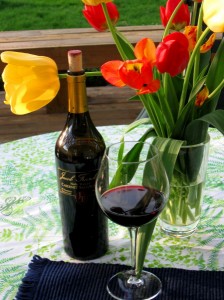
I have long been enamored with the Jacob Franklin Hoffman Lane Cabernet Sauvignon. I have visited the winery for years and gotten to know the good folks at Elyse. They make such a wonderful array of high quality, award winning wines but only one of those wines comes from grapes grown at the actual site of the winery and small tasting room located on Hoffman Lane. It is, of course, the Jacob Franklin Hoffman Lane Cabernet Sauvignon. When you visit the winery, you drive down a quiet lane to the west of Highway 29. If you know Napa well or are a local, you might come up the road running parallel to Highway 29. Regardless of your route, you pass by towering eucalyptus trees before you arrive at Hoffman Lane. The trees perfume the air. The temperature in this part of the valley floor is warm but not scorching hot. In the late fall and winter months, rains tumble down over the nearby westerly mountains and the clouds and bits of fog creep over as well. The location gives a definite quiet sense of place and when you taste a wine from the soil in this area, you begin to recognize the fruit as readily as you do the landscape, wisteria draped gate in the spring and bountiful garden adjacent to the tasting room. It feels personal and as you get to know the fruit of this wine, you feel like you belong, too.
Awhile back, I was making a special dinner and I wanted to pair an equally worthy wine. I had been waiting to do something with the 2007 of the Jacob Franklin Hoffman Lane Cabernet Sauvignon and recently, the time was ideal. The wine in the glass delivers an aromatic bouquet that enchants the nose with aromas of plum, sweet black cherry, bits of pepper, anise, chocolate and bits of earth. The true love affair for me arrives as the wine opens up and suddenly the nose is brushed with a gentle perfume of eucalyptus and drifts to sweet red rose petals. It is this very bouquet that over the years draws my nose, quiets my mind and takes me exactly to the winery on Hoffman Lane because this wine is one of the nicest and purest embodiments of a place that I have encountered in my years of on-site tasting. The palate is not disappointed as the wine slips back and it is rewarded with chewy dried blueberries, cherry and mulberry fruit. On the back of the palate the finish lingers into hints of smooth milk chocolate with a bit of mint.
To pair this, I had planned to incorporate some fresh produce coming out of the garden along with some of the fancier culinary attributes that allow Cabernet Sauvignon to flash its mettle:
- · Peppered Top Sirloin Petite Fillets with Maple-Balsamic Shallot Sauce with Garden Baby Asparagus and Roasted Rosemary-Truffle Potatoes and Pancetta

For those who either attended Middlebury College or were fortunate enough to dine at The Middlebury Inn in Vermont, they will know that there cuisine is a serious affair. The inn does a peppered filet mignon with a maple-balsamic sauce but its sauce involves a bit of bourbon in its recipe. Taking inspiration from this entrée, I decided to use a more affordable yet tender, lean cut of beef and to create a sauce not using the bourbon but incorporating some shallots sautéed in the drippings from some fried pancetta. To make any maple-balsamic sauce or dressing authentic, I used Grade B Vermont Maple Syrup. This flavor cannot be substituted if you are seeking to create the true depth of a sauce that will match the structure of a Cabernet Sauvignon wine. In this case, the Grade B Vermont Maple Syrup meets balsamic vinegar to reduce, to be deglazed and join sautéed shallots and whisked butter. The steaks are peppered and flash seared before being placed in a hot oven to continue to cook yet maintain a juicy, tender texture. The photographs below will show the sauce to the side of the beef with bits of shallot on top of the steak.
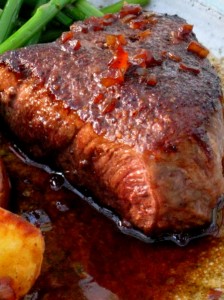

The Maple-Balsamic Shallot Sauce is sheer utter decadence. It also serves wonderfully to wipe up bits of leftover roasted potato or baked bread (should you have that on the table). Spice, sweet and rich flavors meet to create a wonderfully flavorful take on steak and when taken with the wine, it pairs neatly alongside the 2007 Jacob Franklin Hoffman Lane Cabernet Sauvignon. Cabernet Sauvignon in general pairs perfectly with beef due to the balance of drying tannins in the wine versus fat in the beef. In this case, the tannins are not overwhelming in the wine and thus the wine can pair perfectly with a leaner cut of beef. Similarly the depth of flavors in the sauce and the rich flavor of the beef parallel the personality of this Cabernet Sauvignon and match the wine’s structure as well.
To add to the plate, baby asparagus is picked from the garden and baby red fingerling potatoes are roasted.
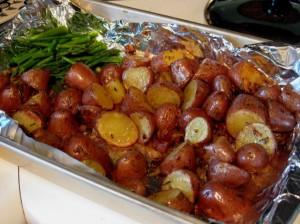
The asparagus is harvested right from the garden to be gently steamed. If you have not grown asparagus yet, by all means do. It is so tender and so naturally sweet that you will never settle for that from the grocery store again. There is absolutely no bitterness whatsoever. It is so tender that it borders on obscene and so sweet that it melts and lingers in your mouth. It pairs breathlessly alongside the meal and with the sauce for the steak. Because of its sweeter nature, it flushes out some of the sweet cherry flavor in the wine.
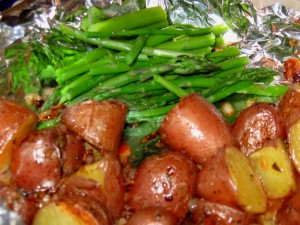
Baby red fingerling potatoes are roasted with rosemary, cracked pepper and sea salt. Once roasted, they are tossed with truffle oil, bits of fried pancetta and sautéed shallots. Rosemary and truffle create a symbiotic balance of herbaceous and earthy notes that draw out the finer elements of the 2007 Jacob Franklin Hoffman Lane Cabernet Sauvignon. The tenderness of the red fingerling potatoes mirrors the soft late evening light of early summer.
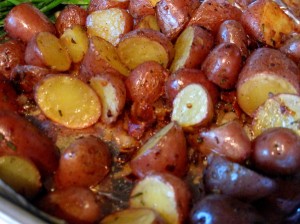
This is an instance in which thoughtful preparation can bring a four or five star gourmet dining experience to your table at home. Doing this at home affords you the leisure to pair a lovely bottle of wine from your own cellar. The result is art on the plate, at the table, in the glass and in your mouth. It encourages us to take a moment and savor the beauty that is readily at our fingertips and that crosses our lips.
